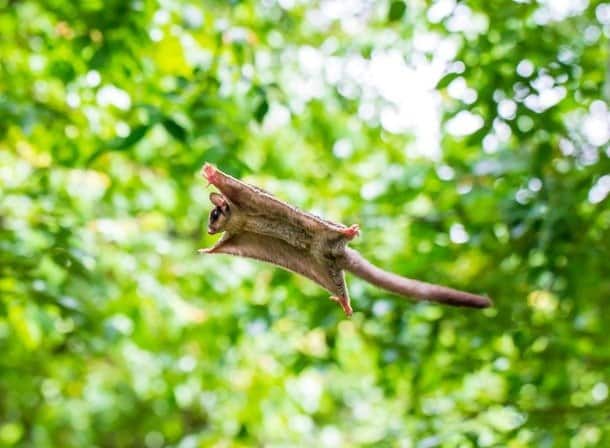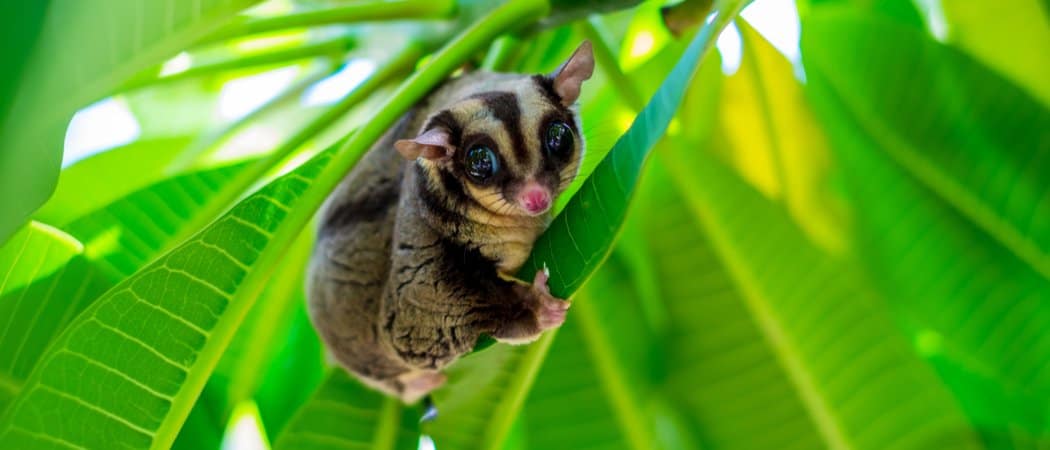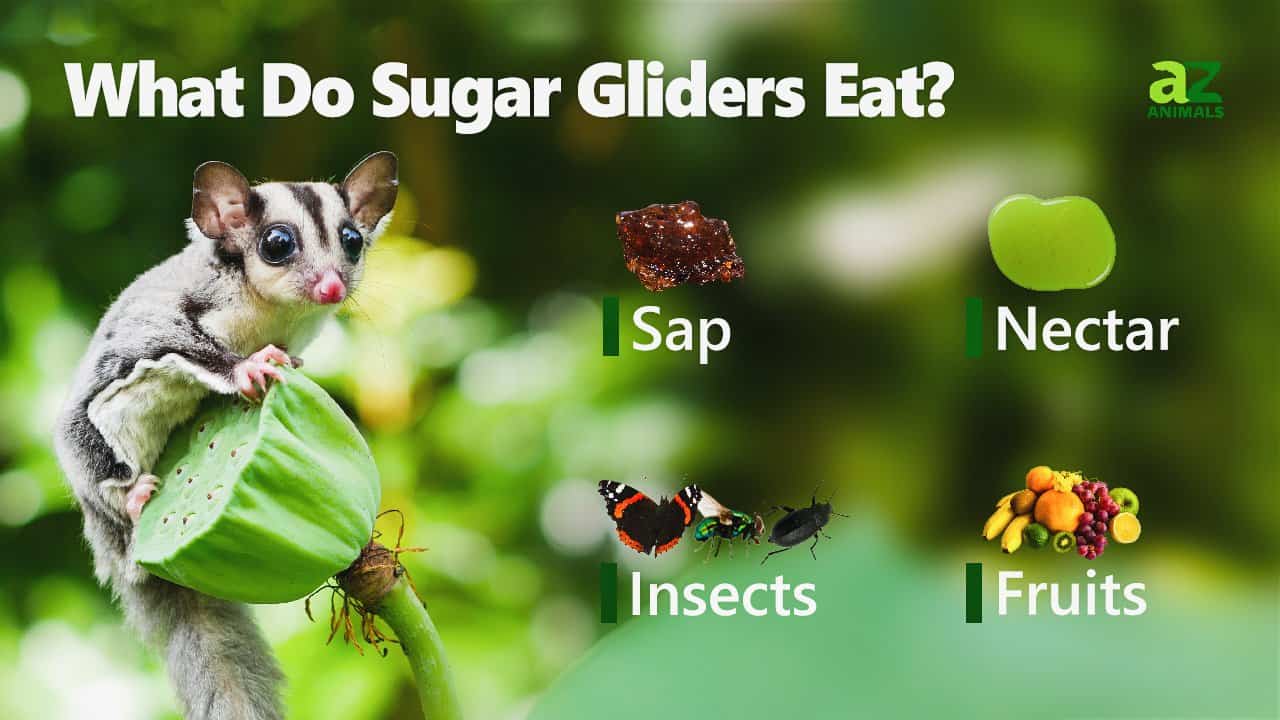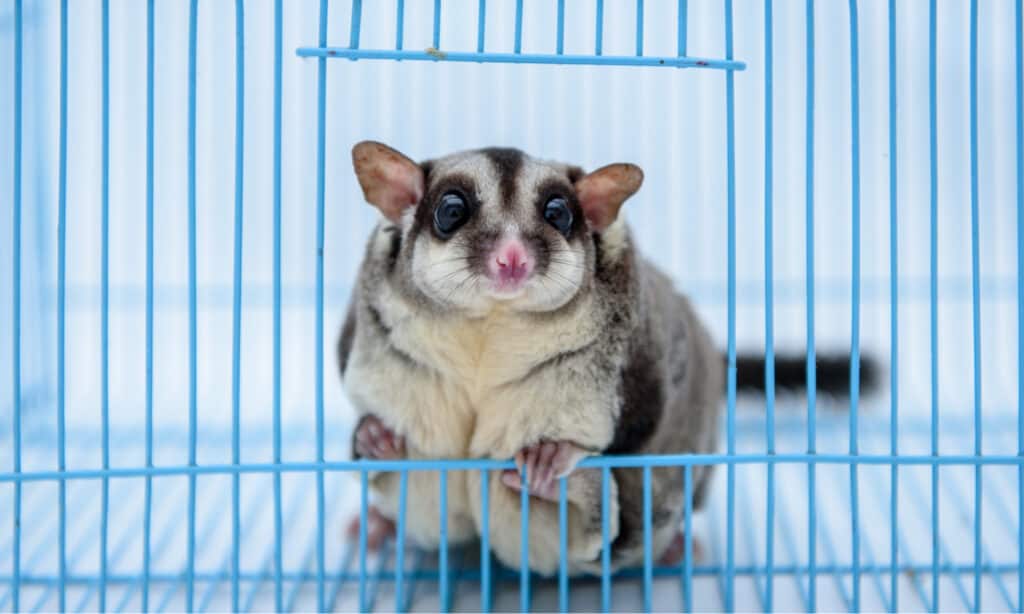Sugar Glider
Petaurus breviceps
Can glide for over 100 feet before touching the ground
Advertisement
Sugar Glider Scientific Classification
- Kingdom
- Animalia
- Phylum
- Chordata
- Class
- Mammalia
- Order
- Diprotodontia
- Family
- Petauridae
- Genus
- Petaurus
- Scientific Name
- Petaurus breviceps
Read our Complete Guide to Classification of Animals.
Sugar Glider Conservation Status
Sugar Glider Facts
- Prey
- Insects, tree gum, sap
- Name Of Young
- joey
- Group Behavior
- Colony
- Fun Fact
- Can glide for over 100 feet before touching the ground
- Biggest Threat
- Habitat loss
- Most Distinctive Feature
- Web membranes
- Gestation Period
- 15 Days
- Litter Size
- 1-2
- Habitat
- Forest, woodlands
- Predators
- Owls, cats, snakes
- Diet
- Omnivore
- Type
- Marsupial
- Common Name
- Sugar glider
- Location
- Australia, Indonesia
Sugar Glider Physical Characteristics
- Color
- Grey
- Black
- White
- Skin Type
- Fur
- Lifespan
- 120 months
- Weight
- 0.1kg-0.25kg (0.25lbs-0.5lbs)
- Length
- 0.15m-0.22m (0.5ft-0.75ft)
- Age of Sexual Maturity
- 1 year
- Age of Weaning
- 3 months
View all of the Sugar Glider images!
“A small, gliding possum with a big sweet tooth.”
Sugar gliders are tiny nocturnal animals that are native to forested and wooded regions in Australia and New Guinea. They have comparable size and appearance to North American squirrel species. However, their classification as marsupials means they are actually more similar to kangaroos, koalas, and possums. Despite their name and a hardy appetite for sweet foods, sugar gliders are actually omnivorous animals and consume a diverse diet that typically fluctuates throughout the year. Despite restrictions in some countries, they are also a popular choice as exotic household pets.
Sugar Glider Facts
- Baby sugar gliders are called “joeys” like their much larger kangaroo cousins.
- Thin membranes attached to their wrists and ankles allow these mammals to glide for over 100 feet without touching the ground.
- Their colonies are typically run by two males who share authority and various responsibilities related to the group dynamic.
- Adults usually have grey-brown fur that is broken up by dark stripes and a white underbelly.
You can check out more incredible facts about sugar gliders.

Scientific Name
In scientific communities, sugar gliders are known by the name Petaurus breviceps. This name is translated as “short-headed springboard” in reference to their remarkable ability to leap and glide long distances. There are also several other names for these animals given by local native peoples, including aymows, kajben, and yegang. This species is part of the Petauridae family in the Mammalia class.
Evolution And History
The sugar glider genus Petaurus is believed to have originated in New Guinea around 8 to 24 million years ago, during the early to mid-Miocene era. This mammal then migrated to Australia where it further diverged and the earliest examples of the species change more closely resembling the sugar glider we see today were believed to have taken place in Australia around 4.46 million years ago.
Types Of

Once classified as a single species, there are now 3 distinct species of sugar gliders.
©i3iwtz/Shutterstock.com
The sugar glider was once classified as a single species but newer research has now indicated that they are actually 3 distinct species.
- Sugar glider (Petaurus breviceps)
- Krefft’s glider (Petaurus notatus)
- Savanna glider (Petaurus ariel)
Additionally, there are currently seven recognized subspecies of sugar gliders found in different regions throughout Australia and the Indonesian islands. The subspecies native to Australia are P. b. breviceps, longicaudatus and ariel. Other subspecies that are found in New Guinea and surrounding islands are P. b. papuanus, tafa, flavidus and biacensis.
Appearance

These are one of the few mammals that have an opposable digit, like the human thumb, that helps them keep their grip.
©LesPalenik/Shutterstock.com
Sugar gliders are often called flying squirrels due to their comparable body structure, size, and prominent tail. Adults are generally 6 to 8 inches in length and weigh between 4 and 6 ounces. They are one of the few mammals that have an opposable digit, like the human thumb, that helps them keep their grip. Their short, soft coat typically appears primarily grey with black stripes and a white belly. Selective breeding in captivity and genetic mutations in the wild have also produced white and cream-colored gliders.
Their most distinctive physical characteristic is patagia, or thin membranes of skin, that stretches from their wrists to their ankles. These wing-like membranes allow them to glide gracefully through the air for distances up to 150 feet. Sugar gliders can also exercise control over their long tail to maintain balance in the treetops and steer them during a glide.

Wing-like membranes allow them to glide gracefully through the air.
©Anom Harya/Shutterstock.com
Behavior
Sugar gliders are animals that live in small groups, called colonies, composed of up to a dozen individuals. The colonies usually feature two dominant males that share authority and subdue other males in the group. The two leading males assume various responsibilities, including scent-marking colony members and territory as well as helping care for offspring. Gliders are mostly active at night and typically forage in an area that spans several acres.
Gliding
As their name suggests, these animals can glide across significant distances by leaping into the air and spreading out the membranes attached to their limbs to maintain lift. They will fall about 1.5 feet for every 2.5 feet of horizontal distance traveled during a glide. Gliding is not only an energy-efficient way to travel, but it’s also an effective way to escape predators in the trees while avoiding those on the ground.
Habitat

Sugar Gliders spend most of their time among tree branches.
©Manop Boonpeng/Shutterstock.com
These tiny marsupials are almost exclusively arboreal, which means they spend most of their time among the branches of trees. Their geographic range is limited to the eastern coasts of Australia, New Guinea, and a few of the surrounding islands. They have a distinct preference for trees in the Acacia and Eucalyptus groups and are dependent on wooded or forested habitats. They are found in both wet and dry environments ranging from wild rainforests to cultivated plantation areas.
Food And Diet

Even though they do have a penchant for sweet stuff, sugar gliders are adaptive omnivores that have different food targets throughout each season. They primarily forage along the underside of the forest canopy, so they have access to a wide diversity of dietary options. They can eat almost 10 percent of their body mass in food each day. Sugar gliders are also capable of entering a state of torpor that allows them to slow down basic body functions in order to conserve energy.
What Do Sugar Gliders Eat?
Insect species and their larvae are their biggest food source during the warmer months of the year. Sugar gliders exhibit remarkable speed and dexterity when they leap from trees momentarily to capture flying insects. They seek out the gum or sap exuded from trees during the cold season, particularly that of the acacia and eucalyptus plants. They are also known to prey on small animals, particularly reptiles, that they come across in their foraging expeditions.
To discover the complete diet of sugar gliders, give ‘What Do Sugar Gliders Eat? 20+ Foods They Love‘ a read!
Predators And Threats

Although their geographic range is narrowing, they are not considered endangered.
©MARVIK/Shutterstock.com
Despite their narrow geographic range and limited habitat preference, sugar gliders are not considered an at-risk species. In fact, they are currently classified as a species of least concern according to wildlife conservationists. The ability to adapt to habitat fragmentation and survive in close proximity to human development has allowed them to fare better than other small possum species that are native to the same regions.
What Eats Sugar Gliders?
Their small size makes them a tempting target for a wide range of predators in their native range, which is why they have to rely on their speed and gliding ability to make frequent escapes from danger. Local owl species are their primary predators, but they can also become a meal for various snakes, kookaburras, goannas, and quolls. Feral and domestic cats are also a serious threat to gliders.
Reproduction, Babies, And Lifespan

Mothers have a pouch on their abdomen suited for housing their babies after they are born.
©I Wayan Sumatika/Shutterstock.com
Female sugar gliders have a pair of ovaries and uteri, much like other marsupials, and can enter heat multiple times in a single year. They also have a pouch on their abdomen suited for housing baby gliders after they are born. Breeding typically occurs between the two dominant males and the various females within a colony. Depending on the subspecies and region, breeding may be limited to certain seasons or occur throughout the year.
They have a short gestation period that lasts around 16 days. Mothers give birth to one or two babies, which crawl directly into their pouch to continue their development. Each baby, called a joey, remains completely in the pouch for about two months and won’t even open their eyes until they are around 80 days old. They leave the nest and start venturing out on their own when they are about 110 days of age.
Sugar gliders typically reach physical and sexual maturity by the time they are a year old, although males may mature a bit faster. Lifespan in captivity ranges from 10 to 12 years, although the average adult only lives for around 5 or 6 years in the wild.
Population
The facts regarding the wild sugar glider population aren’t clear, but conservation authorities have little reason to believe they are in imminent danger and consider them a species of least concern in terms of endangerment. Habitat loss due to wildfires and human development is an ongoing concern that could eventually lead to an observable decline in their numbers. There is also a substantial market for these animals as pets and they make up a sizable portion of the exotic pet market in the United States.
View all 293 animals that start with SSugar Glider FAQs (Frequently Asked Questions)
What is a sugar glider?
Sugar gliders are small marsupials that have a body size and proportions similar to a squirrel. They are nocturnal mammals that spend almost all of their time among the branches and trunks of trees. They are best-known for the membranous “wings” spanning their front and hind legs that allow them to glide through the air.
Are sugar gliders carnivores, herbivores, or omnivores?
These animals are opportunistic and adaptive omnivores that enjoy a diverse diet. Insects are a favored food source when they are available and gliders are known to leap high into the air to capture them. They also like to eat the exuded sap or gum from trees, which provide an energy-rich food source during the cold season.
Are sugar gliders good pets?
While some countries and states in the US have restrictions on domestic ownership of sugar gliders, they are still one of the most popular exotic pets in the world. Their small size, docile nature, longer lifespan, and amusing acrobatics are just a few of the facts that give them strong appeal as a household pet.
Do sugar gliders bite you?
While they are not particularly aggressive, gliders may bare their teeth and bite if they are afraid or curious. Inexperienced owners should exercise caution when handling them and avoid cornering or pursuing them when they are not interested in socializing.
Are sugar gliders high maintenance?
Sugar gliders require a consistent and diverse diet, so owners need to make sure they are providing balanced meals. They also need regular exercise to maintain their high activity levels and should be handled or socialized on a regular basis.
Do sugar gliders like to cuddle?
These animals have a strong social instinct due to their natural group dynamics, so many owners find success in encouraging affection in their animals. However, this process can take time and should be done carefully due to the glider’s fragile body and cautious nature.
What Kingdom do Sugar Gliders belong to?
Sugar Gliders belong to the Kingdom Animalia.
How many babies do Sugar Gliders have?
The average number of babies a Sugar Glider has is 1 to 2.
What's the difference between sugar gliders and flying squirrels?
Sugar gliders are marsupials while flying squirrels are mammals. They also differ in their diets and social behaviors. Read all about these two animals here!
What are the differences between sugar gliders and bush babies?
The primary difference between sugar gliders and bush babies is that bush babies live in Africa while sugar gliders live in Australia and surrounding island. Bush babies are tremendous jumpers while sugar gliders have adaptations to jump between trees in forests.
Thank you for reading! Have some feedback for us? Contact the AZ Animals editorial team.
Sources
- Wikipedia, Available here: https://en.wikipedia.org/wiki/Sugar_glider
- National Geographic, Available here: https://www.nationalgeographic.com/animals/mammals/s/sugar-glider/
- San Diego Zoo, Available here: https://animals.sandiegozoo.org/animals/sugar-glider

















